What is Cervical Pain?
Cervical pain is also known as neck pain or cervicalgia. It is a pain beneath your head and around your spine.
Severe cervical pain brings changes in the discs or joints and bones, connected to the neck. The major cervical pain is due to the wear and tear of the bones and cartilage and is often found in aging people.
According to Ayurvedic science, it occurs due to an imbalance of Vata Dosha. It is called Greeva Graham in Sanskrit. Greeva means neck and graham means stiffness.
Let’s know why this cervical pain takes place.
The causes of Cervical Pain are as follows:
- Improper diet.
- Sedentary lifestyle.
- Aging.
- Injury.
- Excessive physical strain.
- Gastritis.
- Constipation.
- Bloating.
- Growth of bone spurs, tumors, cysts, and masses.
Signs and symptoms of Cervical Pain
- Headaches at the back of the head.
- Swelling on neck, shoulder, and hand.
- Pain around the neck.
- Numbness in arms, shoulder, and neck.
- Weakness.
- Deformity.
- Dizziness.
- Nausea.
5 Effective Yoga Asanas For Cervical Pain
Management of Cervical Pain with Yoga can benefit patients immensely. Hence, practicing yoga asana regularly can reduce swelling and discomfort of people suffering from Cerival pain. Here are five effective yoga asanas:
Makarasana (Crocodile Pose)
It can be useful for people who are suffering from lower back pain. It helps in removing stress or muscular tension as well as improves circulation. Staying in this asana for a prolonged period of time can help normalize the shape of the vertebral column.
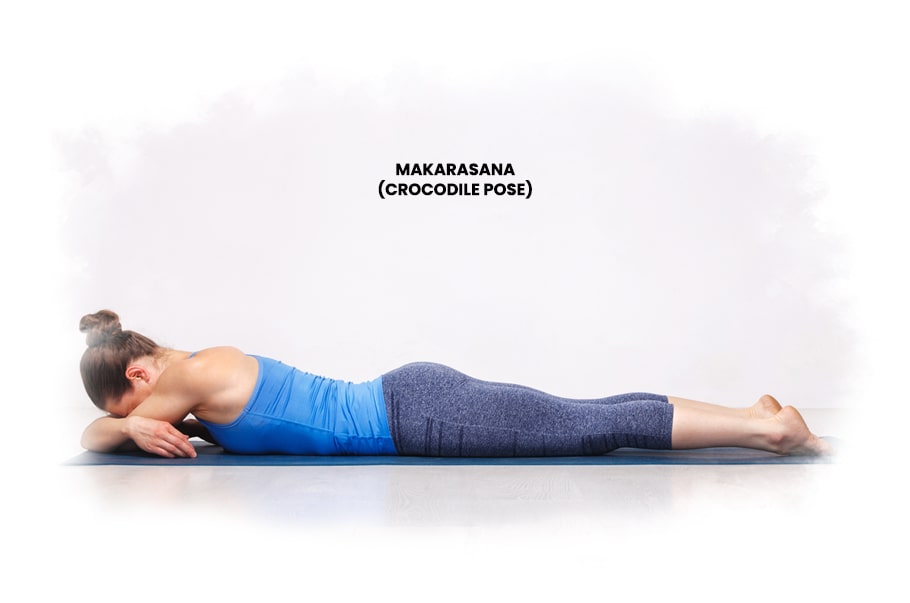
How to perform it?
- Step 1: Lie down flat on your stomach in a prone position.
- Step 2: Bend your right leg, creating a 45-degree angle with your calf and thigh.
- Step 3: Keep your left leg straight behind you.
- Step 4: Place your left cheek on your mat and look towards the right side.
- Step 5: Place your hands underneath your left cheek, like a pillow.
- Step 6: Rest in this pose for up to 10-15 minutes. Breathe deeply. Come back to the original position and repeat the asana.
Setu Bandhasana (Bridge Pose)
It helps in removing stress or muscular tension as well as improves circulation. The best benefit of Setu Bandhasana is the incredible stretching of muscles it offers to your chest, neck, spine, and hips.
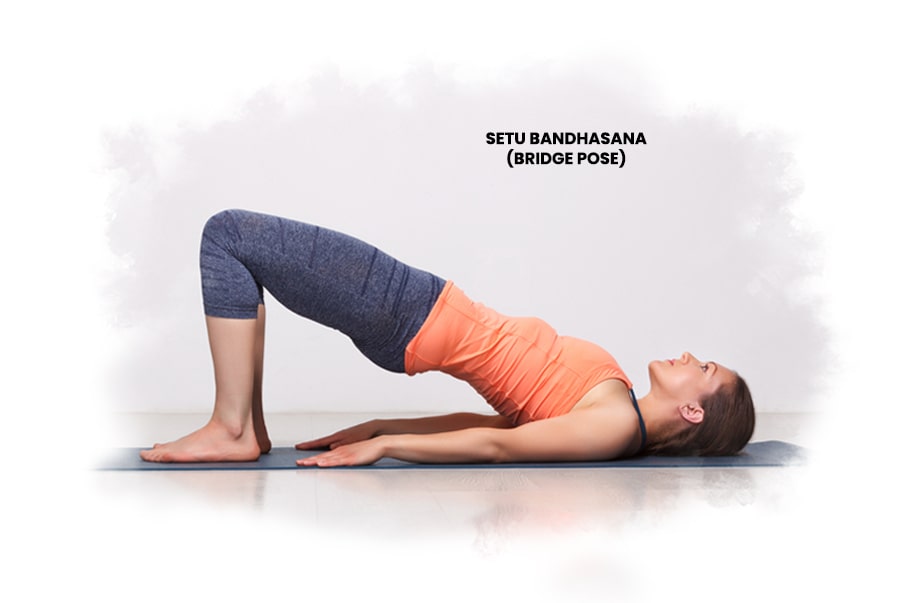
How to perform it?
- Step 1: Lie down on your back straightly on the yoga mat.
- Step 2: Now, bend your knees and keep at least a hip-width distance between your feet. Keep your feet on the ground.
- Step 3: Place your arms along with your body and keep your palms flat on the floor.
- Step 4: Take a deep breath and slowly lift your back. Gradually, roll the shoulders in; touch the chest to the chin without bringing the chin down, balancing your weight with your shoulders, arms, and feet. Feel your bottom firm in this yoga pose. Both thighs are parallel to each other and to the floor.
- Step 5: Support your body on your arms, shoulders, and feet. Additionally, remember to engage your hips and abs.
- Step 6: Keep breathing gradually as well as hold the pose for at least 30-60 seconds. To release it, exhale and lower your back, Relax and repeat this asana.
Bhujangasana (Cobra Pose)
Bhujangasana relieves constipation and helps in the digestion process. Circulation is improved by this pose as well as it strengthens the spine and makes it more flexible. It relieves sciatica pain and strengthens the muscles of the chest, shoulders, arms, and abdomen.
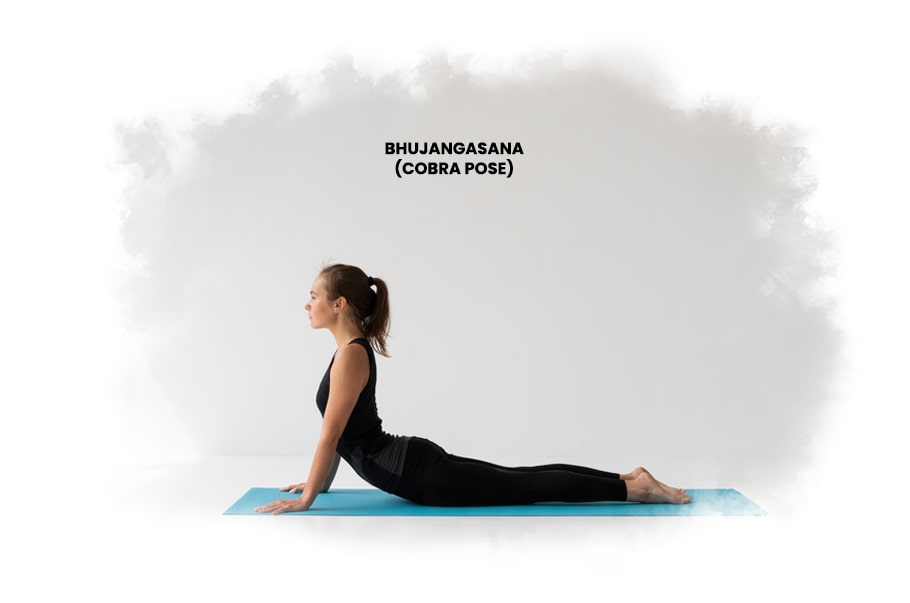
How to perform it?
- Step 1: Begin this asana by lying on your abdomen and resting your forehead on the floor.
- Step 2: Keep your both feet together and your toes touching the ground. Keep your hands at shoulder level and palms on the floor.
- Step 3: During inhalation lift your head up, abdomen, and chest, and make sure that you keep the navel on the floor.
- Step 4: Hold this posture for a few seconds and relax. Come back to the original position and repeat the asana.
Gomukhasana (Cow Face Pose)
This yoga asana stretches the chest, arms, shoulders, hips, and ankles. Overall, it is beneficial for people who lead sedentary life as every part of their body gets stretched with Gomukhasana.
It helps in elongating the spine as the whole body is stretched and it allows a good flow of oxygen from the base of the spine to the head.
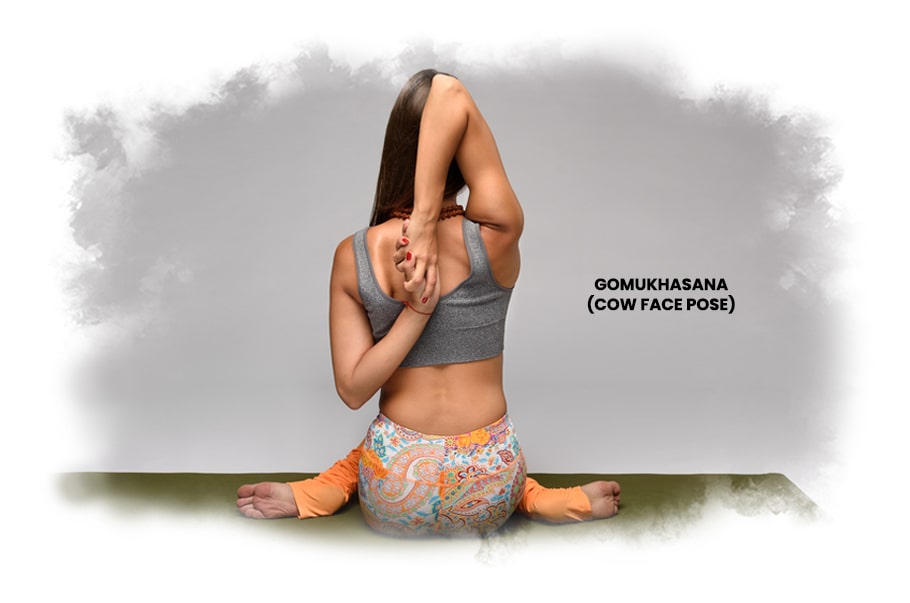
How to perform it?
- Step 1: Sit on the yoga mat with your legs out in front of you. Keep your back straight.
- Step 2: With your right leg bent, tuck your right feet beneath your left buttock.
- Step 3: Place your left knee on top of your right knee.
- Step 4: Bend the left elbow as you raise your right arm above your head. Bring your right arm behind your back and lock both the hands together at the same time.
- Step 5: Take ujjayi breaths deeply and continue for however long you find comfortable.
- Step 6: At this point, let your arms go as you exhale.
- Step 7: Uncross your legs, then do the same with the opposite leg.
Dhanurasana (Bow Pose)
This asana can strengthen the abdominal muscles and help in toning the back. It also helps in stretching the front part of the body, including the abdomen and chest, ankles, thighs, throat, hip flexors, and groin.
Dhanurasana may provide a beneficial effect on all back problems and enhance the digestion process.
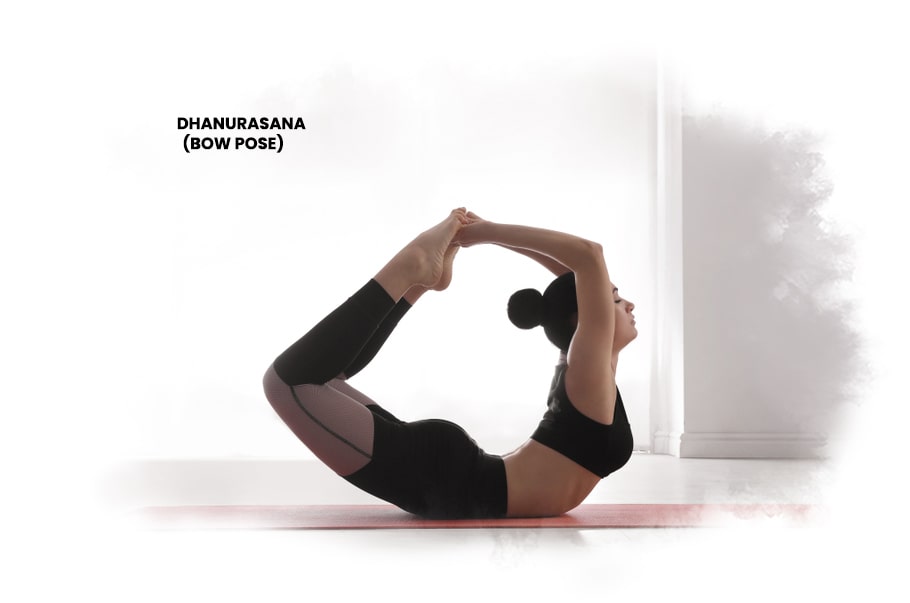
How to perform it?
- Step 1: Begin this pose by lying on your abdomen and keeping your feet apart. Your arms must be at the side of your body.
- Step 2: Fold your knees gradually, take your hands backward, and grab your ankles.
- Step 3: Take a deep breath and lift your chest up from the ground while pulling your legs towards the back. Keep your eyes ahead.
- Step 4: Hold the pose for a few seconds.
- Step 5: To release the pose, exhale deeply and bring your legs and chest to the ground and relax! And repeat this asana.
Ardha Matsyendrasana (Seated Spinal Twist)
This asana helps in the natural alignment of the spinal cord. It releases the lower muscles of the back and provides relief from lower backache. This asana is well known for twisting and rotating the spine.

How to perform it?
- Step 1: Sit up with the legs stretched out straight in front of you, keeping the feet together and the spine erect.
- Step 2: Bend the left leg and move the heel of the left foot beside the right hip.
- Step 3: Now take the right leg over the left knee. Place the left hand on the right knee and the right hand behind you.
- Step 4: Twist the waist, neck, and shoulders in this sequence to the right and look towards the right shoulder. The back should be upright and relaxed.
- Step 5: Hold and continue with gentle deep breaths in and out.
- Step 6: During exhalation, release the right hand first (the hand behind you), release the waist, then the chest, and lastly the neck, and sit up relaxed and straight.
- Step 7: Repeat this asana on the other side. Breathe out, come back to the front, and relax!
Conclusion
In this way, Yoga Asanas for Cervical Pain Relief can do wonders for people who are leading a sedentary life. Practicing yoga asanas not only increases the flexibility of muscles but also relieves the stiffness and pain of muscles. Yoga asanas are an ancient treasure that our ancestors offered to us.
Finding Cervical Pain relief with Yoga might become easier for you if you follow these asanas. Hence, we should value and practice yoga asanas in our daily life to get rid of cervical pain and keep diseases at bay.
